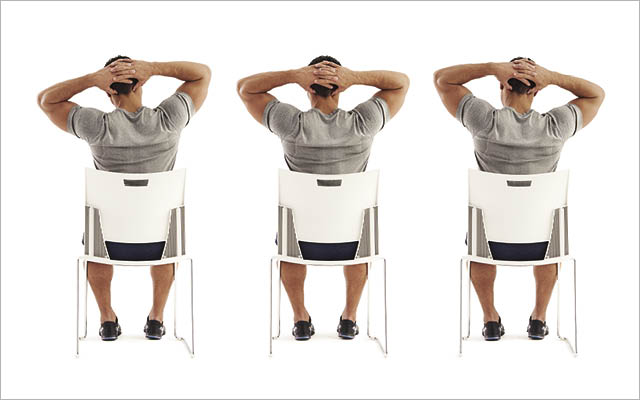Have you ever woken up with a sore or stiff neck — so much so that it hurts to turn your head one way or the other? Sometimes the pain can even extend to your head, shoulders, or arms. These symptoms, also known as neck strain, are irritating and can even interfere with daily activities.
Most often, neck strain happens when you overuse or overstretch your neck muscles, but it can also stem from whiplash, arthritis, or other aggravating events. If left untreated, neck pain and stiffness can get worse, travel to other areas, or lead to other symptoms such as headaches.
Try the following remedies to help find relief.
1. Apply Ice Before Heat
Heat and ice can complement one another and work together to promote healing. Applying both to an overstretched neck may ease strained or torn muscles and help soothe pain.
As a rule of thumb, ice the area immediately upon feeling pain and continue icing for the first 24 to 48 hours. Using a cold compress or ice pack (do not use ice directly on your skin), hold it against the painful area for 15 to 20 minutes every two to three hours. This will help reduce the initial inflammation and swelling.
After the initial 24-to-48-hour period, I typically recommend applying heat, which stimulates blood flow to the area, improves the flexibility of the soft tissues, and aids in the healing process. Try a heating pad for 15 to 20 minutes every two to three hours. You can also try taking a warm shower.
2. Perform Gentle Stretches
Stretching is a helpful remedy for loosening up tight muscles and working to prevent potential flare-ups in the future. Remember to stretch very gently and slowly to avoid further irritation and follow the steps for your chosen exercise carefully. I recommend these simple stretches:
Neck Bending
Moving only your head, slowly lower your chin to your chest while looking down. Hold for 30 seconds and bring your head back upright. Repeat three times.
Next, slowly move your head to one side, bringing your ear toward your shoulder. Hold for 30 seconds before bringing your head back upright. Repeat three times on each side.
Neck Rotation
Turn your head as far to one side as you can without increasing the pain. Hold the stretch for five seconds and then return to a neutral position with your head facing forward. Repeat on the other side. Be sure to only move your head during this stretch — keeping your shoulders and back still.
Shoulder Roll
Stand or sit upright, looking straight ahead with your arms relaxed. Lift your shoulders toward your ears while breathing in. Move your shoulders back and squeeze your shoulder blades together, creating a big circle with your shoulder joints. Exhale as you drop your shoulders. Repeat 10 times.
Read more: “How to Get Rid of a Stiff Neck” and “9 Do-Anywhere Stretches to Ease Back Pain”
3. Seek Chiropractic Care
A neck adjustment by a professional chiropractor can help manipulate misaligned joints and loosen tight muscles. Neck and spinal manipulation can also help restore mobility to weakened joints and tissues as well as correct forward head posture by relieving soreness and stiffness in your neck.
A chiropractor will perform a thorough examination of your neck, upper back, and shoulders to determine where the pain and stiffness is coming from. Once the root cause is identified, the chiropractor will create a treatment plan to help restore mobility and function for your soft tissues and joints. Seeking care as soon as you experience pain can typically resolve issues more quickly than compared to delaying treatment.
4. Consider Acupuncture
Acupuncture is an ancient Chinese medical practice where a practitioner inserts small needles into specific pressure points on your body to treat a variety of conditions. It can help reduce inflammation throughout the body, release tight muscles and trigger points, and help energy flow more freely to encourage healing and recovery.
Ask your chiropractor if they recommend acupuncture for your specific condition. You can ask them for a referral or search for certified acupuncturists in your area.
5. Take Movement Breaks
If your regular routine involves sitting for multiple hours per day (in a car or at a desk, for example), inserting movement breaks can help you to avoid stiff muscles. Sitting with poor posture and holding your neck in one position for a prolonged period is linked to the worsening of pain and stiffness.
Stand up, take a short walk, and gently stretch your neck often. Try setting a regular alarm on your phone to remind you to get up and move every hour or so.
Read more: “What Are Good Stretches to Do After Sitting All Day?”
6. Improve Your Workspace Ergonomics
Adapting your work area to fit your body’s needs can go a long way toward easing pain and stiffness. To make your workspace more ergonomic, try the following tips:
- Get an adjustable office chair and set it for a comfortable sitting posture where you’re able to keep your feet flat on the floor and your knees a little lower than your hips.
- Maintain proper sitting posture. Sit with a straight back and keep your arms level with your desk.
- Set your computer at eye level by placing your monitor or laptop on an adjustable stand (or even just a large book or box) if needed.
- When you’re seated and looking at your screen, remember to position your ears, shoulders, and hips in a straight line to support your weight evenly through your spine.
- Place any documents on a stand-up clipboard next to your monitor. This way, you won’t have to constantly move your head up and down while working.
- Keep your elbows near your body while using your mouse and keyboard. This will help you put less pressure on your shoulder muscles.
- Take calls with a headset. Holding a phone in the crook of your neck is one of the fastest ways to a stiff neck.
7. Restrict Activities That Cause Pain
Depending on the severity of your pain and discomfort, you may benefit from a period of rest ranging from a few days to a few weeks. If you’re seeking the care of a chiropractor, they can advise on rest time and help you choose which activities to avoid or suggest alternatives. If a particular activity triggers pain, it’s best to avoid it until you’re feeling better. For example, consider limiting heavy lifting, rigorous exercise, or other strenuous activities.
8. Sleep With the Right Pillow
I recommend using a pillow with a contour that supports your neck’s natural curve to help relieve and prevent neck pain. No matter what position you sleep in, you want your head to be in the same position as if you were standing upright.
To check for this, lay down on your bed, allow your body to settle in, and assess the height of your head and pillow. Does your head feel aligned with your spine? If not, you may be adding stress on your neck joints and the soft tissues in your head while you sleep.
Everybody is different, so there’s not a specific type of pillow or pillow filling that I recommend. However, you can find pillows that are adjustable (through adding or removing filling) that I find work well. It may take a little trial and error to find the right pillow for your body and sleeping position.





